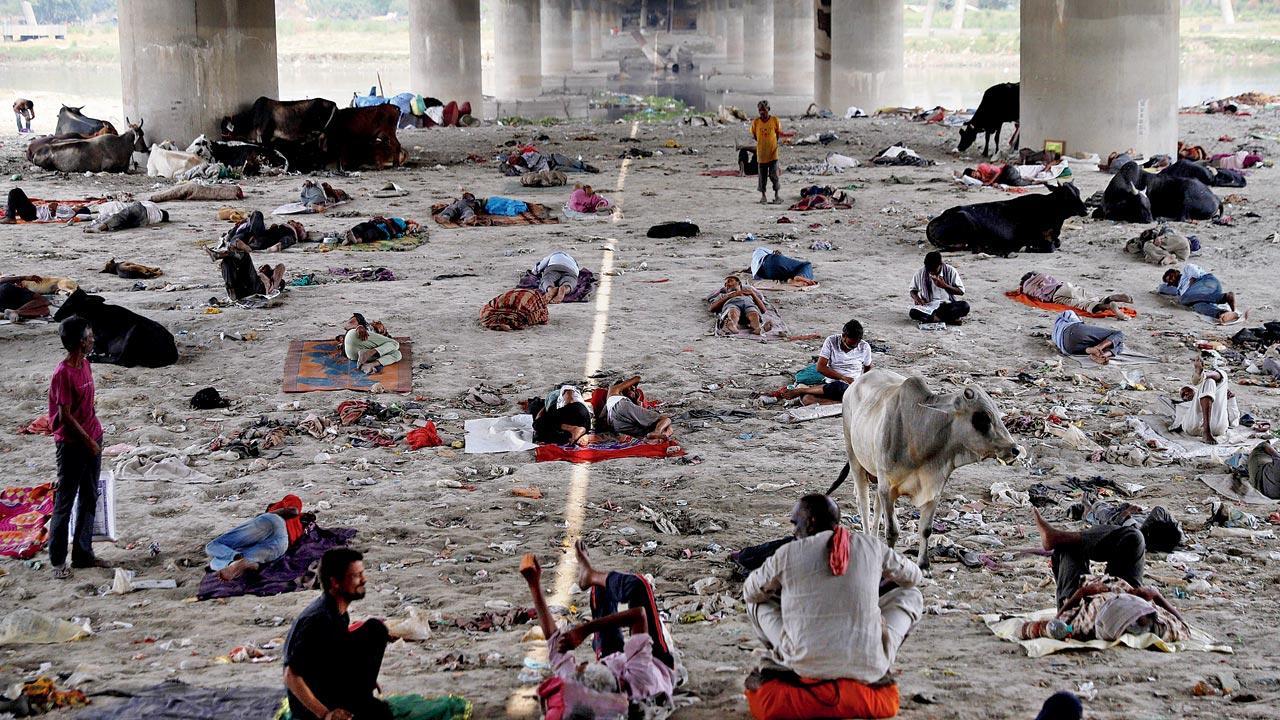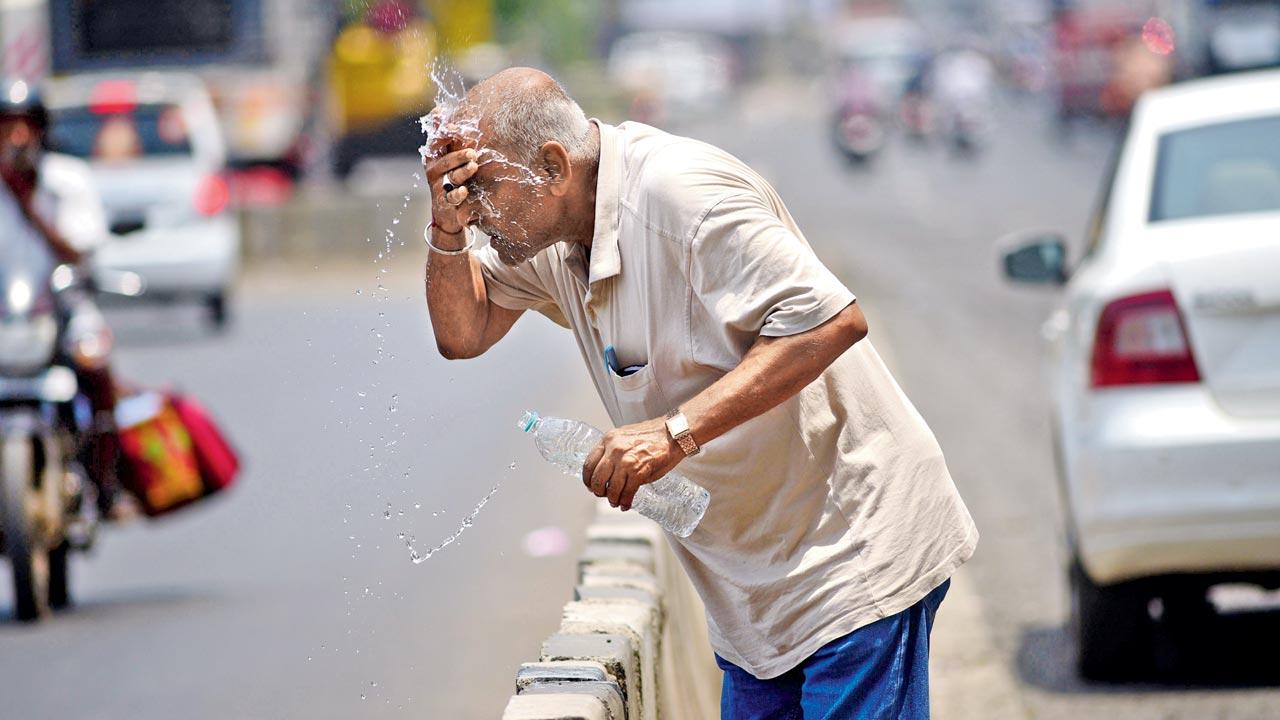The co-author of a new Cambridge study that says rising mercury will affect crop yield, progress and productivity, tells mid-day that the solutions lie in our roots

People take cover under a bridge at the Yamuna River bed on a hot summer day in New Delhi in May last year. The heatwaves in the country in 2022 prompted the researchers at Cambridge University to undertake the study. Pic/Getty Images
Earlier this month, a heatstroke incident at a political rally in Navi Mumbai resulted in the death of 14 people. While the ‘loo’ is common in central and northern states, such a tragedy in Mumbai is not the norm. Mumbai’s hottest day so far was in early March at 39.3 degrees (last year, it came in April at 39.6 Celsius); in Chandrapur, mercury touched 43.2 degrees Celsius; it was 42.2 in Amravati and Solapur; and 41 degrees in Nagpur in mid-April.
A recent study, titled Lethal Heatwaves Are Challenging India’s Sustainable Development, published in PLOS Climate Journal, throws light on the severity of rising temperatures and the impact on development. Published on April 19 by the University of Cambridge, it is authored by Dr Ramit Debnath, Dr Ronita Bardhan and Michelle L Bell. “April 2022 was the hottest in 122 years and followed the hottest March on record, reportedly killing at least 25 people,” reads the introduction of the study. Bardhan, Associate Professor of Sustainable Built Environment at the University of Cambridge, says they started research last year, “when India was facing massive heatwaves, it triggered us to understand the implication”.
Edited excerpts from an interview
How could heatwaves slow or reverse progress towards Sustainable Development Goals (SDG)?
The Department of Science and Technology has a good indicator called the national Climate Vulnerability Indicator (CVI) that measures any sort of vulnerability arising from climate change. [It is a composite index that uses various indicators—such as percentage of households below poverty line, proportion of rain-fed agriculture, percentage of women in overall workforce—to measure socio-economic features and livelihood, biophysical, institutional and infrastructural characteristics].
These are based on scientific framework similar to SDG, so progress on the CVI index should indicate progress in SDG. However, there isn’t any CVI indicator to measure the physical consequences of climate evils such as heat stress, which will impact developmental efforts in many sectors.
We implemented the Heat Index (HI) using the temperatures of April 2022 in every state and assumed that exposure to a hazard such as extreme heat can significantly impact climate vulnerability. Measuring of this impact is currently missing in the government’s vulnerability assessment through CVI. States such as Odisha, Andhra Pradesh and West Bengal showed highest climate vulnerability to HI, but not as per CVI.
 A Mumbaikar splashes water on his face to get relief from the extreme heat. The city recorded its hottest day this year in the first week of March at 39.3 degrees Celsius, six degrees above normal. Pic/Pradeep Dhivar
A Mumbaikar splashes water on his face to get relief from the extreme heat. The city recorded its hottest day this year in the first week of March at 39.3 degrees Celsius, six degrees above normal. Pic/Pradeep Dhivar
The study says almost 90 per cent of Indians are more vulnerable to public health issues and have an increased risk of death...
When you look at heatwave as just temperature thresholds, it is difficult to co-relate how it affects health. But HI tells us how a person feels in a particular temperature. For instance, 32 degrees Celsius would feel different in Mumbai and Delhi due to varying humidity levels.
Around 50 per cent humidity at 28 to 30 degrees temperature is comfortable, and we may not switch on the AC. Beyond this, the physiological stress to the human body increases. When it is unable to thermoregulate, it leads to heat related distress or illness such as heat strokes that can be fatal. And most of the population doesn’t have facilities such as ACs.
What do you mean by Delhi’s heat exaggerating indoor overheating?
We now use construction materials that store and create heat islands [An urban heat island occurs when a city experiences much warmer temperatures than nearby rural areas]. When the sun sets, the temperature indoor rises, which is why most houses need AC-cooling at night. Ideally, homes in subtropical climes should be designed such that heat trapped in the day is released at night. The other issue is lack of ventilation opportunities between constructions. Buildings don’t have adequate distance between them so residents shut windows for privacy, restricting air flow. In a low-income habitat, the indoor heat build-up leads to an unbearable temperature at night, putting a high burden on health.
 Dr Ronita Bardhan
Dr Ronita Bardhan
Is the rapid urbanisation affecting Mumbai’s ability to deal with heatwaves?
Mumbai’s major problem is humidity. We did a study in 2018, and found out that highrises do not restrict better wind flow. It is the arrangement of blue, green and brown that has a consequence on heat—blue is water, green is the green cover and brown represents buildings. We found that a highrise, which has heat sinks [areas that can absorb the heat and not store the heat] like adequate green and water bodies, with sufficient facility of wind flows is actually cooler for a longer duration in the night; this means they are not creating hotspots [a relatively high temperature in comparison to its surroundings]. But highrise buildings with less green or blue space, trap the heat and are sources of heat zones.
What were some other alarming findings in your study?
The consequences of intra-variability, for one: Low and high income populations live close to each other. The running of ACs intensifies heat in a neighbouring low-income cluster. The heat emanating from an AC unit gets trapped and keeps re-circulating. We are not taking into account any of these factors in climate contingency plans.
Can heat waves worsen the food crisis?
When climate patterns change, so do crop patterns. There is also a direct correlation to productivity: How can a farmer work in extreme heat? Their [farmers] productivity will be affected—the heat will make them so sick that they will not be able to work; this is a vicious cycle that has a strong correlation to productivity and crop yield.
How can India tackle this impending crisis?
Concentrated action in the right direction is required. Climate action plans are knee-jerk reactions to extreme events, more reactive than proactive. Heat is not alien to us. We have social cooling practices, such as summer food habits and architecture that drove heat away using courtyards and balconies, which have evolved over time. This is where the essence of sustainable development lies—when we realise local capability and potential.
Currently, there is no mapping of local wisdom, which will soon be lost to modernisation.
Solutions for Mumbai will be different from what works for other cities, and those are embedded in our cultural practices and social norms. It is important for us to capture and track those.
Our recent research in Mumbai shows that the solution lies with the people. A video titled, Home: A Clime Action, posted a month ago on the YouTube channel of Public Engagement, discusses how residents of Mumbai and Ethiopia can tackle the climate crisis.
24,000
No. of deaths since 1992 due to cumulative heatwave mortality
What’s the weather like?
From January 2022 to October 2022, the country recorded 242 days of extreme weather events, making it nearly one extreme event daily. These include co-occurrence of extreme heat waves and cold waves in the north and western parts, drought in central India, and high flooding in the coastal plains along with landslides in the north eastern region
By 2050, heatwaves could cross the survivability limit for a healthy human resting in the shade. This will impact productivity, economic growth, and quality of life of around 310 to 480 million people.
By 2060, most parts of India, including those in peninsular India and the coasts will see an increase in the duration of heatwave by 12-18 days, according to the Indian Meteorological Department
By 2100, more frequent precipitation and consequent floods, cyclonic storms, warming, heatwaves, and sea-level rise is predicted
Delhi is at ‘danger’ Heat Index levels
The Delhi government’s assessment shows that the South and North-East Delhi are most vulnerable to climate change impacts, which are also the most affluent areas. However, the authors’ estimation shows that 100 per cent of the city is at ‘Danger’ Heat Index levels. In addition, by downscaling the HI to the district level, results show that even the ‘low’ climate-vulnerable areas in Delhi are at high heatwave risks. “This is concerning as the current heat-action plans are designed and implemented as per the Delhi government’s vulnerability assessment, which does not include HI estimations. In addition, the high intensity of development in Central, East, West and North-East districts (i.e., the old Delhi area) can further elevate the HI risks through heat island formation,” say the authors.
 Subscribe today by clicking the link and stay updated with the latest news!" Click here!
Subscribe today by clicking the link and stay updated with the latest news!" Click here!










